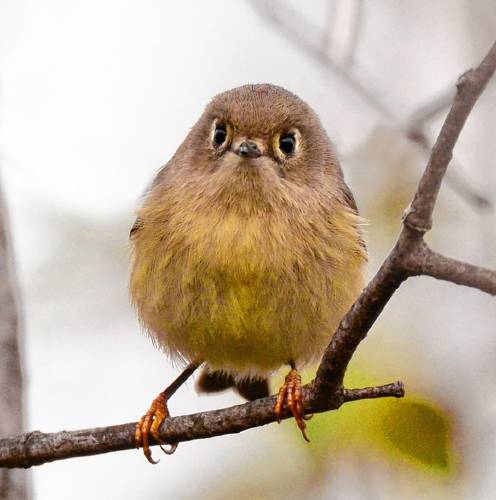Speaking of Nature: Small but sassy: Ruby-crowned kinglet sighting a welcome respite from the news

This tiny ruby-crowned kinglet is giving me the stink eye as my camera takes rapid-fire photos. PHOTO BY BILL DANIELSON
| Published: 10-23-2023 5:00 AM |
As more and more of the national and international news seems to be increasingly depressing and alarming, I imagine that many of you, like myself, might be looking for solace wherever you can find it. It might be losing yourself in the spirit of the upcoming Halloween celebrations, or it might be just sitting quietly and reading a pleasant book. Whatever your source of comfort may be, I totally understand. A little self-soothing goes a long way sometimes.
For me, solace is found in the company of my feathered friends that visit the feeders on my deck. The regular reader will be no stranger to my delight at having chickadees land on my head while I sit and enjoy the quiet of the meadow by my Thinking Chair. However, I rarely speak of the forest that lies to the south of my meadow and it is this area that provided me with a little burst of joy just the other day.
Head south from the Thinking Chair and you find yourself walking into a mixed forest of Beech-Birch-Maple and a smattering of Eastern Hemlock. The Hemlocks like the cooler, wetter places and they are joined there by a good number of Eastern White Pines as well. The forest floor is relatively flat and there isn’t much understory because of the maturity of the forest. Keep walking, placing one foot carefully after another and you will eventually reach a spot where the ground dives down toward a large stream. Witch Hazel trees grow here along with a fair number of oaks.
But it is back in that large stand of pines and hemlocks that I want to stop. The shade of these large trees is so complete that virtually nothing grows underneath them. It is a prime spot for looking for owl pellets because they sit on the ground with nothing to cover them up. The mature pines have very large trunks that are spaced far apart and this creates what my beautiful wife Susan likes to call a “park-like setting.” It is a wonderful place to sit down, lean against a tree and just listen to the wind.
During the summer, this area is surprisingly quiet. Treetop birds, like Scarlet Tanagers and Eastern Wood-pewees may flit about the canopy, but very few birds actually venture down to the ground. In the winter, however, this seems to change and there are a few species of birds that will come down.
Black-capped chickadees often form the heart of roving bands of songbirds and they will be joined by Downy Woodpeckers, White-breasted Nuthatches, Tufted Titmice, Brown Creepers and, if you are lucky, Ruby-crowned Kinglets. It is that last little bird that I will focus on for the rest of today’s column.
When it comes to little birds, there are few smaller than the Ruby-crowned Kinglet (Corthylio calendula). Measuring in at a diminutive 4.25 inches in length, the only birds smaller than the Ruby-crowned Kinglet would be the Winter Wren and Golden-crowned Kinglet (both at 4 inches in length) and the Ruby-throated Hummingbird (at 3.75 inches in length). What is even more interesting is the fact that these tiny little birds spend the winter up in Canada and then they fly over 1,000 miles to the south where they winter in the southern United States and Mexico. We only see these guys on their way through and I was lucky enough to see three of them as they searched for migration fuel.
I had first picked up on their presence while walking in the woods, but the problem is that they are so diabolically small and fidgety that capturing a photo of one was impossible. This was only exacerbated by the fact that it was quite gloomy underneath those mature pines. So I watched them as they moved along and then I myself migrated over to the Thinking Chair. I placed out some seed for the chickadees and in no time at all they were swarming all around me with excitement.
Article continues after...
Yesterday's Most Read Articles
 1989 homicide victim found in Warwick ID’d through genetic testing, but some mysteries remain
1989 homicide victim found in Warwick ID’d through genetic testing, but some mysteries remain
 Fogbuster Coffee Works, formerly Pierce Brothers, celebrating 30 years in business
Fogbuster Coffee Works, formerly Pierce Brothers, celebrating 30 years in business
 Greenfield homicide victim to be memorialized in Pittsfield
Greenfield homicide victim to be memorialized in Pittsfield
 Real Estate Transactions: May 3, 2024
Real Estate Transactions: May 3, 2024
 Battery storage bylaw passes in Wendell
Battery storage bylaw passes in Wendell
 As I See It: Between Israel and Palestine: Which side should we be on, and why?
As I See It: Between Israel and Palestine: Which side should we be on, and why?
But the real treat came when I discovered that the Ruby-crowned Kinglets had followed them.
Conditions for photography were much better (that’s the reason I placed the Thinking Chair were I did, after all) and even on a cloudy day there was ample light for taking pictures … if only the little buggers would cooperate. Ruby-crowned Kinglets don’t show much interest in seeds. Instead, they are interested in spiders and insects that might be hiding in the nooks and crannies of tree bark. The activity of the chickadees did not escape them, however, an eventually one flew over just to gawk.
It was this bird, posing on a bare branch with no obstructions, that presented itself for portrait photography for about 10 seconds. I took full advantage of my camera’s speed and pressed down on the shutter button for the entire time. Most of the photos were blurry, but three were clear and I selected the last of them because I think the bird’s expression is so hilarious. At the top of the bird’s head you can see the slightest hint of red for which the species is named and you can imagine the cartoon thought bubble above its head saying, “What the hell is that noise?” The little bird is staring right at me and is giving me the “stink eye.” Glorious!!
So that’s it for today folks. There is still a lot of autumn to enjoy and I will try to focus in on one or two more flowering plants while they are still blooming, but birds are slowly going to become the main focus of my columns because everything else is battening down the hatches in preparation for winter. I hope that you are able to get outside and enjoy the odd patch of sunshine on a clear day and I would recommend walking off into the woods and leaning against a tree for a while. The sound of the wind through the branches is soothing in itself, but the bright, twinkling specks of bird life that may pass your way are well worth waiting for.
Bill Danielson has been a professional writer and nature photographer for 26 years. He has worked for the National Park Service, the US Forest Service, the Nature Conservancy and the Massachusetts State Parks and he currently teaches high school biology and physics. For more in formation visit his website at www.speakingofnature.com, or go to Speaking of Nature on Facebook.

 Speaking of Nature: Indulging in eye candy: Finally, after such a long wait, it’s beginning to look like spring is here
Speaking of Nature: Indulging in eye candy: Finally, after such a long wait, it’s beginning to look like spring is here Celebrating ‘Seasonings’: New book by veteran preacher and poet, Allen ‘Mick’ Comstock
Celebrating ‘Seasonings’: New book by veteran preacher and poet, Allen ‘Mick’ Comstock Faith Matters: How to still the muddy waters of overthinking: Clarity, peace and God can be found in the quiet spaces
Faith Matters: How to still the muddy waters of overthinking: Clarity, peace and God can be found in the quiet spaces A time for every purpose under heaven: Free sing-a-long Pete Seeger Fest returns to Ashfield, April 6
A time for every purpose under heaven: Free sing-a-long Pete Seeger Fest returns to Ashfield, April 6
